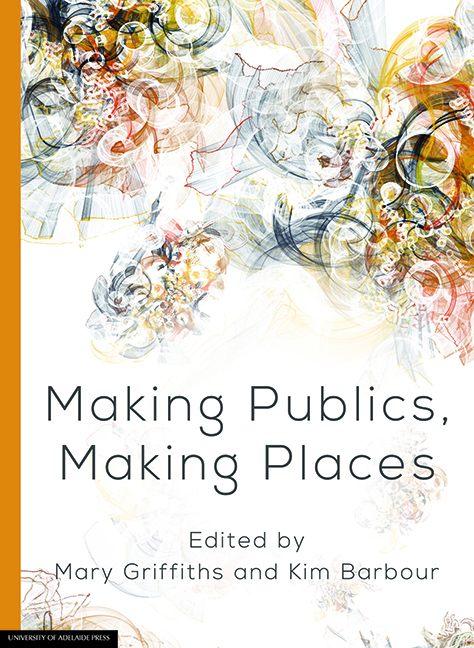Book contents
- Frontmatter
- Contents
- Preface
- Abstracts
- List of contributors
- 1 Making publics, making places
- 2 The elasticity of the public sphere: Expansion, contraction and ‘other’ media
- 3 ‘Imagine if our cities talked to us’: Questions about the making of ‘responsive’ places and urban publics
- 4 Picturing placelessness: Online graphic narratives and Australia's refugee detention centres
- 5 Reclaiming heritage for UNESCO: Discursive practices and community building in northern Italy
- 6 Find your Adelaide: Digital placemaking with Adelaide City Explorer
- 7 Chinese films and the sense of place: Beijing as ‘Thirdspace’ from In the Heat of the Sun to Mr Six
- 8 Social media and news media: Building new publics or fragmenting audiences?
- 9 The use of Chinese social media by foreign embassies: How ‘generative technologies’ are offering opportunities for modern diplomacy
- 10 An opinion leader and the making of a city on China's Sina Weibo
- 11 Public audiencing: Using Twitter to study audience engagement with characters and actors
- 12 Overcoming the tyranny of distance? High speed broadband and the significance of place
3 - ‘Imagine if our cities talked to us’: Questions about the making of ‘responsive’ places and urban publics
Published online by Cambridge University Press: 28 July 2017
- Frontmatter
- Contents
- Preface
- Abstracts
- List of contributors
- 1 Making publics, making places
- 2 The elasticity of the public sphere: Expansion, contraction and ‘other’ media
- 3 ‘Imagine if our cities talked to us’: Questions about the making of ‘responsive’ places and urban publics
- 4 Picturing placelessness: Online graphic narratives and Australia's refugee detention centres
- 5 Reclaiming heritage for UNESCO: Discursive practices and community building in northern Italy
- 6 Find your Adelaide: Digital placemaking with Adelaide City Explorer
- 7 Chinese films and the sense of place: Beijing as ‘Thirdspace’ from In the Heat of the Sun to Mr Six
- 8 Social media and news media: Building new publics or fragmenting audiences?
- 9 The use of Chinese social media by foreign embassies: How ‘generative technologies’ are offering opportunities for modern diplomacy
- 10 An opinion leader and the making of a city on China's Sina Weibo
- 11 Public audiencing: Using Twitter to study audience engagement with characters and actors
- 12 Overcoming the tyranny of distance? High speed broadband and the significance of place
Summary
The digital world is converging with the physical world, and this phenomenon, known as the Internet of Things, represents the next era of computing. It is one where just about anything can be connected, through sensors and data to other objects, environments, people and, of course, the Internet. (Altimeter Group 2015)
The range of technical, social, environmental and political issues raised by the possibility of ‘just about anything’ being invisibly connected is overwhelming in breadth, scale and depth. The seamlessness of the connectivity predicted is unprecedented in human history and there are as yet few convincing full-scale examples in connected buildings, or in consumer supply chains enabled by the Internet of Things [IoT], or in smart cities, to illustrate how it works in practice. Critical issues already identified include a controversial means of data collection, which makes new forms of urban planning and placemaking as a ‘whole-ofcity’ enterprise possible; and related governmental techniques through which city populations (and specific publics) can be involved in designing their own governance. Yet initiatives exist (some of which will be used to illustrate this chapter's arguments) which cast light on the ways that smart technologies are starting to shape everyday experiences of the material world, and generate new relations of power.
In this chapter, the making of places and publics is addressed through the prism offered by the nascent Internet of Things and locative technologies in the ‘smart city’. The smart city can be defined as an urban digital infrastructure supporting, amongst other activities, technologically-enabled responsive environments. These spaces are governed by big data collected by various means, which allow ‘the city’ to talk back to its inhabitants by offering real time information and a range of choices designed to alter behaviour or encourage different relationships to place. The chapter aims firstly to identify the drivers of the rapid adoption of ‘smartification’ by cities and users, and then to canvass the democratic and participatory factors involved in implementing radical change, noting the risks which may occur in the rush to connect on such a global scale.
- Type
- Chapter
- Information
- Making Publics, Making Places , pp. 27 - 48Publisher: The University of Adelaide PressPrint publication year: 2016



